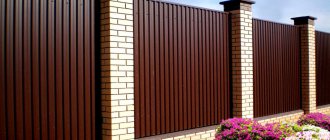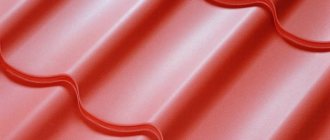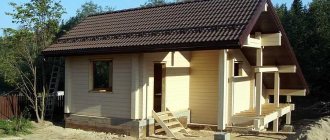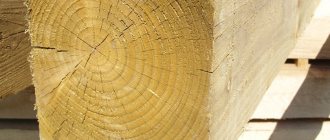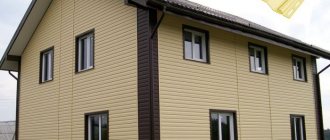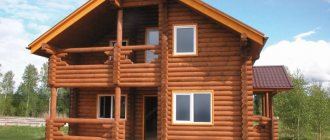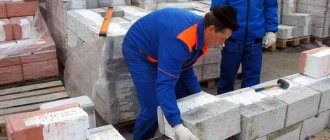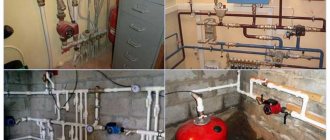What is corrugated sheeting
Profiled sheet or corrugated sheet, or as it is also called, corrugated sheet, is a popular facing building material made from galvanized steel sheet with a thickness of 0.4 to 0.9 millimeters using the cold rolling method, during which the product acquires various corrugated shapes (wavy, square , trapezoidal and others) in order to increase rigidity.
The corrugated sheet can be galvanized or with an additional polymer coating of different colors. The polymer is applied to one or two sides of the sheet. The most common option is one-sided application of the polymer. In this case, a protective layer of paint and varnish is applied to the back side of the corrugated sheet.
Corrugated sheeting is used on the roofs of various types of buildings, construction of external fencing, fences, wall cladding of private and commercial buildings, hangars, warehouses, garages.
Total and usable width
Rolled thin sheet steel, which is used to make corrugated sheets, has a standard width of 1250 mm. After running on a rolling mill, the width of the profiled sheet changes due to the formation of corrugations. The more corrugation and the higher it is, the smaller the width of the resulting profiled sheet. For example, the width of C8 corrugated sheet is 1200 mm, and the width of H75 corrugated sheet is already 800 mm.
The total width is the actual width of the profiled sheet. Useful width is the width of the part of the corrugated sheet that does not overlap with another sheet during overlap installation. Those. the useful width multiplied by the number of corrugated sheets is the width that these corrugated sheets will cover after overlapping installation.
But the declared useful width is not always what it actually is. For example, if you use a profiled sheet as a roofing material, then for flat roofs it is recommended to install the sheets with an overlap in two waves (which reduces the usable width) so that during heavy rains and melting snow on the roof, water does not seep through at the joints.
For profiled sheets, a standard has been developed in Russia - GOST 24045-94 (Bent steel sheet profiles with trapezoidal corrugations for construction), which strictly regulates the dimensions of the corrugated sheet and other parameters of the material, including the thickness of galvanization.
What is marking and what is it used for?
To choose the appropriate type of corrugated sheeting, you need to look at its markings, which are a combination of letters and numbers. The main marking of profiled sheets is based on their possible scope of application and profile height, which ranges from 8 to more than 100 millimeters.
The areas of use of corrugated sheets in construction allow us to classify them into three main types - load-bearing, wall and universal. They are marked respectively with the letters “N”, “S”, “NS”. There are also other types of corrugated sheeting, with different letter markings, for example: “PC”, “MP”, “PG”. But they are much less common on the market than the previous three, so we will not dwell on them.
Marking - meaning of letters
- Profiled sheeting “N” (load-bearing). Profile height of 35 millimeters or more. With its help, reliable roofs, canopies, ceilings, including suspended ones, blind formwork, overlapping and other load-bearing structures are installed. To produce corrugated sheets with this marking, steel up to 0.9 millimeters thick is used. The corrugation of this profile has an increased height, sometimes exceeding 100 millimeters. Such high-profile sheets are more often used in the construction of commercial and industrial buildings. In private construction, corrugated sheeting with a much lower wave height is usually in demand. Some types of “N” grade corrugated sheets have special ribs that increase the rigidity of the roof, as well as additional longitudinal recesses through which excess moisture drains from the roof without entering the space under the roof.
- Corrugated sheeting “C” (wall). The height of this profile is up to 44 millimeters. It is intended mainly for covering walls, erecting vertical partitions, fences, fences. For this corrugated sheet, cold-rolled steel up to 0.6 millimeters thick is used. This brand of corrugated sheet has a very low load-bearing capacity, which in most cases does not allow its use as a roofing covering. An exception (with many reservations) is when the height of this profile is at least 17 millimeters, and it is mounted on a reliable rafter system with durable and as frequent lathing as possible.
- Profiled sheeting "NS" (universal). This load-bearing wall profile with a height of 44 millimeters is for universal use in all areas - installation of fences, gates, load-bearing structures, roofing and walls. All its characteristics and indicators are average: the height of the profile, the thickness of the metal used, as well as strength and cost for the consumer. This is why NS profiled sheeting is used very often in individual construction. Because it is convenient to purchase and deliver to the site a large batch of corrugated sheets of one parka, one size and often one color, and then in a short time cover the roof of the house, the walls of the garage with it and install a new reliable fence.
Selecting the brand of material
When thinking about which corrugated sheeting to use for the roof, it is important to know its numerical index. According to the wave height and sheet thickness, several types of material are distinguished
Profile marked C21
Available in the form of a trapezoid of standard length (2, 3 and 6 m). To complete the roof, you need to focus on the dimensions of the corrugated sheeting: width 1.05 m, wave height 21 microns and thickness 0.4 - 0.7 mm. The metal material is suitable for creating a roof covering on sparse sheathing or as garage cladding.
Roofing profiled sheet C44
It is most convenient to work with sheets with a width of 1.47 m. The height of the corrugated sheet laid on the roof is 44 microns, and the thickness varies from 0.5 to 0.8 mm. The profile is reinforced with additional stiffening ribs and provides for the construction of a roof on sheathing in increments of 2 m, as well as frames for gazebos or cabins.
Corrugated sheeting with index NS45
The construction of a home roof can be carried out from corrugated sheets with a width of 1.06 mm. The recommended thickness is 0.5-0.8 mm, and the profile height is 35 mm. The rigidity and strength of the material guarantee the reliability of the roofing on the sheathing in increments of 4.5 m. Having decided on the material, do not forget that its price depends on the alphanumeric index.
Popular brands of corrugated sheets
- Corrugated sheeting "S-8" is the cheapest and most economical brand on the market. It is suitable for walls, fences, suspended ceilings and light partitions, but initially has low strength and therefore has some limitations in use.
- Corrugated sheeting “S-10” with a coating of the appropriate color imitates a wooden fence well. Suitable for wall installation.
- Corrugated sheet "S-17" for multi-purpose use. Suitable for the manufacture of good enclosing structures, and with some reservations, for work on the roof. Often comes with a double-sided polymer coating.
- Corrugated sheeting “S-18” is suitable for installation on some roofs; its sheets are perfectly connected to each other. A double-sided polymer coating gives this profile additional aesthetic and physical qualities.
- Corrugated sheeting “S-21” has good rigidity and is rightfully considered one of the most popular profiles on the market.
- “S-44” corrugated sheeting is for narrow applications - it is usually used on vertical structures, metal structures, and when facing walls in order to give them new decorative and protective functions.
- Corrugated sheeting “N-57” can be called a profiled sheet for universal use. It really has a wide range of applications, for which it is appreciated by consumers.
- Corrugated sheeting “N-60” for metal roofing. Withstands high loads. It is used for the construction of quickly erected buildings, private houses and large facilities - commercial, industrial, sports. This corrugated sheet can cover long rafter gaps of up to four meters without additional supports.
- Corrugated sheeting “N-75” is used mainly for ceilings, external metal roofing and sheathing. This profile is popular for use in conjunction with metal structures, metal frames in different geographical areas. The N-75 profile is not afraid of serious snow and wind loads. Thanks to its high strength, it can withstand enormous force stress even over large spans. It is advisable to use it in the construction of large shopping centers, industrial buildings and structures, as well as large sports facilities.
- Corrugated sheeting "N-114" is one of the most reliable profiles with high load-bearing capacity. On the stiffening rib it is reinforced with an additional fracture. It is used in many construction areas: monolithic floors, permanent formwork, roofing, large-area canopies, etc.
- Corrugated sheeting “N-158” is the highest grade of steel profile in Russia (158 millimeters!). The sheathing step for it is huge and can reach nine meters. It ideally solves the problem of maximum load-bearing capacity without significantly increasing the weight of the structure.
- Corrugated sheeting "NS-35" is used both in roofing work and for the design of vertical wall structures. Deservedly considered one of the most versatile and popular profiled sheets, it is used in both private and commercial construction. Although commercial applications still use a little more, individual developers are more often interested in a similar profiled sheet, but with a corrugation height of 21 millimeters. Roofs, small and large architectural forms, wall installation, frame buildings of any size, fences and ceilings, dachas and cottages - these are the areas of use of NS-35.
Corrugated roofing - which one to choose?
Which corrugated sheeting is best for the roof of a house? In order to choose corrugated roofing, you must first know what load it will have to withstand in the future. It will consist of snow load and wind load indicators.
All parameters for each region are publicly available and calculated long ago.
Taking the third snow region as an example, we can determine the snow load to be 180 kg/m2 and the wind load to be 32 kg/m2. It is worth noting that these indicators are also significantly affected by the slope of the roof.
Therefore, to determine the wind load in each specific case, the calculated data must be multiplied by the ratio of the height of the roof and the length of its projection onto the horizontal surface.
When choosing, you should also remember to add the mass of the material itself , since it must also withstand itself.
CAREFULLY!
The technical characteristics of each type of flooring indicate the maximum load that the material can withstand. Having found the optimal value, you only need to calculate the number of sheets needed.
It is best to use grade N corrugated sheeting for the roof , which is a load-bearing material that can withstand high pressure. Depending on the installation method and the type of flooring itself, it can withstand from 184 to 916 kg/m2. This is directly affected by the sheathing, sheet thickness, corrugation shape and the presence of stiffeners . Protection in the form of paint or polymer coating also plays an additional role.
Which corrugated sheeting is better for the roof? One of the best options is the H series
The main brands of corrugated sheets produced by TPK Metalroofing Center
Profiled sheeting "S-8"
This type of profile has a wide working surface - 1150 millimeters. This means that less material is used during construction than with other brands of corrugated sheeting. But you should remember about the minimum height of this profile and the thickness of the metal, which limits the scope of use of this profiled sheet.
Profiled sheeting "S-21"
Corrugated sheeting has such a characteristic as the type of overlap. For “S-21” sheets, the overlap occurs along the bottom wave, that is, correctly. If you are looking for fencing material, this is perhaps the best choice. Thanks to its height of 21 millimeters, “S-21” can be used on other objects: facades, ceilings, partitions and even roofing. But when doing roofing work, do not forget about reliable sheathing with a minimum pitch. The symmetry of the profile allows you to work economically, reducing waste to a minimum.
Profiled sheeting "S-44"
This profile is also distinguished by the correct overlap along the lower wave. It is ideal for the construction of fences and gates. You can easily make various partitions, façade cladding, and ceilings from it. Roofing is also one of the possible areas of application of this profiled sheet. But for its installation, it is recommended to pay special attention to reliable sheathing with a minimum step. The symmetry of the profile and its affordable price allow significant savings during construction. Today, profiled sheets of the “S-44” brand have gained enormous popularity in Russia. And the exemplary ratio of quality and price makes it one of the clear market leaders.
Profiled sheeting "NS-10"
For “NS-10” sheets the overlap is also correct, along the bottom wave. It would also be correct to use this profile for the construction of fences, facades and roofs. If the roof slope has a slight slope, then to give additional strength under this corrugated sheet it is better to use sheathing with the minimum possible pitch. The symmetry of this profile allows you to minimize waste and work with it economically, but effectively even in areas of complex shape.
Profiled sheeting "NS-21A"
Today this is one of the most popular types of metal profiles from the Metal Roofing Center. The combination of a beautiful appearance, good rigidity, and low weight made it one of the most versatile and in demand for finishing facades, building roofs and fences. It should be remembered that, depending on the front and back sides, corrugated sheeting “NS-21” is produced in two versions - A and B.
Characteristics of decorative coatings
Modern paints have a noticeable impact not only on design, but also on operational properties - they protect the zinc layer from oxidation processes and scratches. The highest quality finishing coatings can increase the service life of roofs by approximately 20–25%. What types of paints are used to coat the external surfaces of profiled sheets?
Polyester
The most popular protective coating among users. The reason is good performance at a relatively low price. The surface can be matte or glossy. Suitable for all climate zones, not afraid of heat and low temperatures. Does not fade when exposed to sunlight. The coating is plastic, not afraid of bending, and has excellent adhesion to metal surfaces. The thickness of the paint layer is at least 35 microns. Disadvantage - low mechanical strength, easily scratched, the lower layers of the protective anti-corrosion coating are exposed.
Corrugated sheeting with polyester coating
Pural
The paint thickness is 50 microns, the composition is modified with polyamide in order to increase physical strength. Retains original characteristics when heated to a temperature of +120°C. Disadvantage: sharp bends are not recommended. Microcracks may appear in these places, and over time they tend to expand. It is used quite often, and is somewhat more expensive than polyester.
Pural and Pural Matt coatings
Plastisol
The thickness of the coating, depending on the type of metal profile, can be 200 microns, due to this the surface is embossed. The coating is very resistant to mechanical damage and has special additives that protect against the negative effects of UV rays.
Corrugated sheeting coated with Plastizol
PVDF
The most modern, high-quality and expensive coating. It is rarely used for metal profiles due to its high cost. Coating thickness up to 30 microns. The composition includes 20% acrylic and 80% polyvinyl chloride. Practically does not react to ultraviolet radiation. Excellent tolerance to high heating and cooling temperatures. It is characterized by the highest mechanical strength and has good ductility.
PVDF polymer coating
